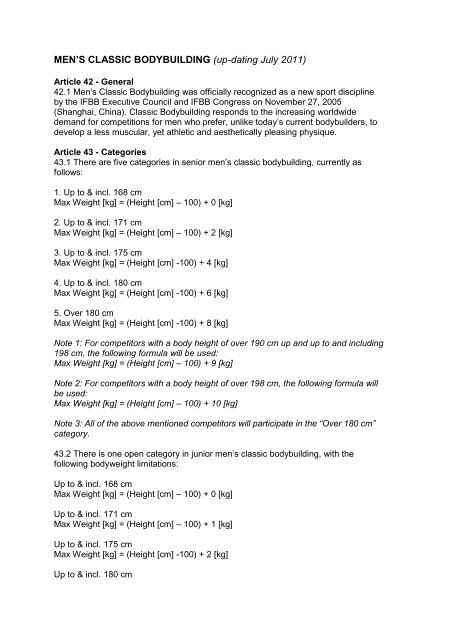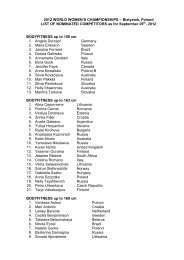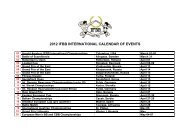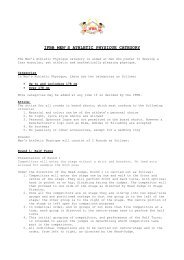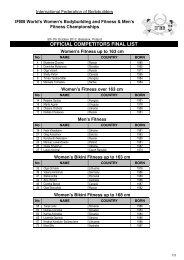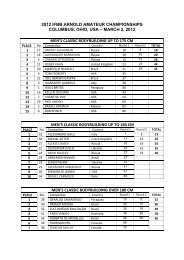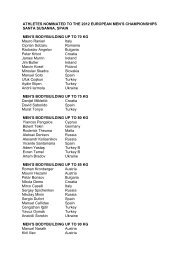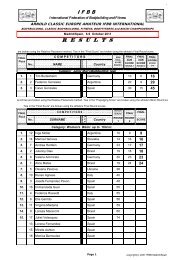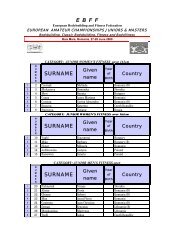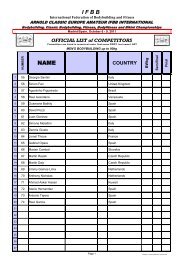Men's Classic Bodybuilding Rules - updated July, 2011 - IFBB
Men's Classic Bodybuilding Rules - updated July, 2011 - IFBB
Men's Classic Bodybuilding Rules - updated July, 2011 - IFBB
You also want an ePaper? Increase the reach of your titles
YUMPU automatically turns print PDFs into web optimized ePapers that Google loves.
MEN’S CLASSIC BODYBUILDING (up-dating <strong>July</strong> <strong>2011</strong>)<br />
Article 42 - General<br />
42.1 Men’s <strong>Classic</strong> <strong>Bodybuilding</strong> was officially recognized as a new sport discipline<br />
by the <strong>IFBB</strong> Executive Council and <strong>IFBB</strong> Congress on November 27, 2005<br />
(Shanghai, China). <strong>Classic</strong> <strong>Bodybuilding</strong> responds to the increasing worldwide<br />
demand for competitions for men who prefer, unlike today’s current bodybuilders, to<br />
develop a less muscular, yet athletic and aesthetically pleasing physique.<br />
Article 43 - Categories<br />
43.1 There are five categories in senior men’s classic bodybuilding, currently as<br />
follows:<br />
1. Up to & incl. 168 cm<br />
Max Weight [kg] = (Height [cm] – 100) + 0 [kg]<br />
2. Up to & incl. 171 cm<br />
Max Weight [kg] = (Height [cm] – 100) + 2 [kg]<br />
3. Up to & incl. 175 cm<br />
Max Weight [kg] = (Height [cm] -100) + 4 [kg]<br />
4. Up to & incl. 180 cm<br />
Max Weight [kg] = (Height [cm] -100) + 6 [kg]<br />
5. Over 180 cm<br />
Max Weight [kg] = (Height [cm] -100) + 8 [kg]<br />
Note 1: For competitors with a body height of over 190 cm up and up to and including<br />
198 cm, the following formula will be used:<br />
Max Weight [kg] = (Height [cm] – 100) + 9 [kg]<br />
Note 2: For competitors with a body height of over 198 cm, the following formula will<br />
be used:<br />
Max Weight [kg] = (Height [cm] – 100) + 10 [kg]<br />
Note 3: All of the above mentioned competitors will participate in the “Over 180 cm”<br />
category.<br />
43.2 There is one open category in junior men’s classic bodybuilding, with the<br />
following bodyweight limitations:<br />
Up to & incl. 168 cm<br />
Max Weight [kg] = (Height [cm] – 100) + 0 [kg]<br />
Up to & incl. 171 cm<br />
Max Weight [kg] = (Height [cm] – 100) + 1 [kg]<br />
Up to & incl. 175 cm<br />
Max Weight [kg] = (Height [cm] -100) + 2 [kg]<br />
Up to & incl. 180 cm
Max Weight [kg] = (Height [cm] -100) + 3 [kg]<br />
Up to& incl. 190 cm<br />
Max Weight [kg] = (Height [cm] -100) + 4 [kg]<br />
Up to& incl. 198 cm:<br />
Max Weight [kg] = (Height [cm] – 100) + 4.5 [kg]<br />
Over 198 cm:<br />
Max Weight [kg] = (Height [cm] – 100) + 5 [kg]<br />
Article 44 - Rounds<br />
44.1 Excluding the Elimination Round, Men’s <strong>Classic</strong> <strong>Bodybuilding</strong> consists of the<br />
following three rounds:<br />
1. Prejudging: Round 1 - Quarter Turns and Compulsory Poses.<br />
2. Finals: Round 2 - Compulsory Poses and Posedown<br />
3. Finals: Round 3 - Posing Routine<br />
Article 45 - Prejudging: Elimination Round<br />
45.1 An Elimination Round is held when there are more than 15 competitors in a<br />
category and is carried out as follows, under the direction of the <strong>IFBB</strong> Chief Judge or<br />
Stage Director:<br />
1. The entire line-up is brought onstage, in numerical order and in a single line.<br />
2. The line-up is divided into two equal-size groups and is positioned onstage so that<br />
one group is to the left of the stage; the other group is to the right of the stage. The<br />
center portion of the stage is left open for comparison purposes.<br />
3. In numerical order, and in groups of not more than five competitors at a time, each<br />
group is directed to the center-stage area to perform the following four Compulsory<br />
Poses:<br />
a. Front Double Biceps<br />
b. Side Chest<br />
c. Back Double Biceps<br />
d. Abdominals and Thighs<br />
4. On completion of the Compulsory Poses, the entire line-up is reformed into a<br />
single line, in numerical order, before exiting the stage.<br />
Article 46 - Prejudging: Scoring of the Elimination Round<br />
46.1 The scoring for the Elimination Round is carried out as follows:<br />
1. If there are more than 21 competitors, the judges shall select the top 15<br />
competitors by placing an “X” beside their numbers.<br />
2. If there are 16 to 21 competitors, the judges shall eliminate 1 to 6 competitors by<br />
placing an “X” beside their numbers.<br />
3. Only the top 15 competitors advance to Round 1.
4. The judges use Form #1; the statisticians use Form #2.<br />
Article 47 - Prejudging: Attire for Round 1 (Quarter Turns and Mandatory<br />
Poses)<br />
47.1 The attire for Round 1 is posing trunks, which must conform to the following<br />
criteria:<br />
1. Plain opaque in style.<br />
2. Solid black in colour.<br />
3. Cloth fabric in material (no plastic, rubberized, or similar material).<br />
4. Matt in texture (no shiny material).<br />
5. No ornamentation, frills, lacework edges and/or borders.<br />
6. At least 1 cm high on the sides and covering a minimum of one-half of the gluteus<br />
maximus and all of the frontal area.<br />
7. No footwear.<br />
8. No jewellery or other accessories, except for a wedding ring.<br />
Article 48 - Prejudging: Presentation of Round 1 (Quarter Turns and Mandatory<br />
Poses)<br />
48.1 Round 1 is held when there are more than 6 competitors in a<br />
category and is carried out as follows, under the direction of the <strong>IFBB</strong> Chief Judge or<br />
Stage Director:<br />
1. The entire line-up is called onstage, in a single line and in numerical order.<br />
2. The line-up is divided into two equal-size groups and is positioned onstage so that<br />
one group is to the left of the stage; the other group is to the right of the stage. The<br />
center portion of the stage is left open for comparison purposes.<br />
3. In numerical order, and in groups of no more than six competitors at a time, each<br />
group is directed to the center-stage area to perform the following four Quarter Turns<br />
and four Mandatory Poses:<br />
a. Quarter Turn Right<br />
b. Quarter Turn Back<br />
c. Quarter Turn Right<br />
d. Quarter Turn Front<br />
e. Front Double Biceps<br />
f. Side Chest<br />
g. Back Double Biceps<br />
h. Abdominals & Thighs<br />
4. This initial grouping of competitors, and performance of the four Quarter Turns and<br />
four Mandatory Poses, is intended to assist the judges in determining which<br />
competitors take part in the comparisons of the Mandatory Poses.<br />
5. Judges may now submit individual requests for comparisons of the Mandatory<br />
Poses to the <strong>IFBB</strong> Chief Judge or Stage Director. No less than three are to be compared<br />
at any one time. The <strong>IFBB</strong> Chief Judge or Stage Director has the discretion to discard or<br />
amend a judge’s individual request for comparisons if warranted.
6. All individual comparisons are to be carried out center-stage and in the order, from<br />
left to right, as requested by the judge.<br />
7. The total number of comparisons will be as decided by the <strong>IFBB</strong> Chief Judge or<br />
Stage Director.<br />
8. All competitors undergo at least one comparison.<br />
9. On completion of the last comparison, the entire line-up is reformed into a single<br />
line, in numerical order, before exiting the stage.<br />
10. The seven Mandatory Poses are as follows:<br />
a. Front Double Biceps<br />
b. Front Lat Spread<br />
c. Side Chest<br />
d. Back Double Biceps<br />
e. Back Lat Spread<br />
f. Side Triceps<br />
g. Abdominals and Thighs<br />
Article 49 - Prejudging: Scoring of Round 1 (Quarter Turns and Mandatory<br />
Poses)<br />
49.1 The scoring of Round 1 is carried out as follows:<br />
1. Each judge awards each competitor an individual placing, ensuring that no two or<br />
more competitors receive the same placing.<br />
2. With nine judges, two high and two low scores are discarded. The remaining<br />
scores are summed to produce a “Round 1 Subscore” and a “Round 1 Placing”.<br />
3. Ties in the “Round 1 Subscore” are broken using the Relative Placement method.<br />
4. The judges use Form #3; the statisticians use Form #5.<br />
5. The top six competitors advance to the Finals (Round 2 and Round 3).<br />
Article 50 – Prejudging: Assessing Round 1 (Quarter Turns and Mandatory<br />
Poses)<br />
50.1 Round 1 is assessed using the following criteria:<br />
1. The judge should first assess the overall male athletic appearance of the physique.<br />
This assessment should begin at the head and extend downwards, taking the whole<br />
physique into account. The assessment, beginning with the general impression of the<br />
physique, should take into consideration the hair and facial features; the overall<br />
athletic development of the musculature; the presentation of a balanced,<br />
symmetrically developed physique; the condition of the skin and the skin tone; and<br />
the athlete’s ability to present onstage with confidence.<br />
2. During the comparisons of the Mandatory Poses, the judge should first look at the<br />
primary muscle group being displayed. The judge should then survey the whole<br />
physique, starting from the head, and looking at every part of the physique in a<br />
downward sequence, beginning with general impressions, and looking for muscular
ulk, balanced development, muscular density and definition. The downward survey<br />
should take in the head, neck, shoulders, chest, all of the arm muscles, front of the<br />
trunk for pectorals, pec-delt tie-in, abdominals, waist, thighs, legs, calves and feet.<br />
The same procedure for back poses will also take in the upper and lower trapezius,<br />
teres and infraspinatus, erector spinae, the gluteus group, the leg biceps group at the<br />
back of the thighs, calves, and feet. A detailed assessment of the various muscle<br />
groups should be made during the comparisons, at which time the judge has to<br />
compare muscle shape, density, and definition while still bearing in mind the<br />
competitor’s overall balanced development. The comparisons of the compulsory<br />
poses cannot be over-emphasized as these comparisons will help the judge to<br />
decide which competitor has the superior physique from the standpoint of athletic<br />
balanced development, muscular density and definition.<br />
3. The physique should be assessed as to the level of overall muscle tone, achieved<br />
through athletic endeavours. The muscle groups should have a round and firm<br />
appearance with a small amount of body fat.<br />
4. The assessment should also take into consideration the tightness and tone of the<br />
skin. The skin tone should be smooth and healthy in appearance.<br />
5. The judge’s assessment of the athlete’s physique should include the athlete’s<br />
entire presentation, from the moment he walks onstage until the moment he walks<br />
offstage. At all times the competitor must be viewed with the emphasis on a “healthy,<br />
fit, athletic-looking muscular physique, in an attractively presented total package”.<br />
Article 51 - Finals: Attire for the Round 2 (Compulsory Poses and Posedown)<br />
51.1 The attire for Round 2 is the same as in Round 1.<br />
Article 52 - Finals: Presentation of Round 2 (Compulsory Poses and Posedown)<br />
52.1 Presentation of Round 2:<br />
The procedures for Round 2 will be as follows:<br />
1. Only the top six competitors from Round 1 advance to Round 2.<br />
2. The top 6 finalists are brought onstage, in a single line and in numerical order.<br />
Each competitor is introduced by number, name and country.<br />
3. The top 6 finalists will perform the 7 compulsory poses, as a group and at the<br />
same time, in the middle of the stage. After the 7 th pose, the chief judge will reverse<br />
the order of the competitors and will repeat the seven compulsory poses once again.<br />
This round will be scored.<br />
4. As soon as the compulsory poses are completed, the <strong>IFBB</strong> Chief Judge will call for<br />
a 60-second posedown to music of the Organizer’s choice. This part of Round 2 will<br />
not be scored.<br />
5. After the Posedown, the top 6 finalists are reformed into a single line, in numerical<br />
order, before exiting the stage.<br />
Article 53 - Finals: Scoring of Round 2<br />
53.1 The scores for Round 1 are used only to place the competitors from 1 st to 15 th<br />
and to determine the top 6 finalists who then advance to Round 2 and Round 3. The
top 6 finalists start the finals with zero points.<br />
The scoring of Round 2 is carried out as follows:<br />
2. Only the Compulsory Poses are scored; the Posedown is not scored.<br />
3. Each judge awards each competitor an individual placing, ensuring that no two or<br />
more competitors receive the same placing.<br />
4. With nine judges, two high and two low scores are discarded. The remaining five<br />
scores are summed and then multiplied by 2 to produce a “Round 2 Subscore”.<br />
5. The judges use Form #6; the Statisticians use Form #5.<br />
Article 54 - Finals: Assessment of Round 2<br />
54.1 Assessment of Round 2:<br />
The same criteria used in judging Round 1 will be used in this round. However, the<br />
judges must be mindful of the fact that a competitor may present a different condition<br />
in the finals compared to the Prejudging. Therefore, judges must ensure that this<br />
round is judged from a “fresh” perspective, ensuring that all competitors receive fair<br />
assessment based upon their presentation in this round.<br />
Article 55 - Finals: Presentation of Round 3 (Posing Routines)<br />
Round Three will immediately follow the Round Two (Compulsory Poses).<br />
55.1 Round 3 is carried out as follows, under the direction of the <strong>IFBB</strong> Chief Judge or<br />
Stage Director: each competitor is called onstage, individually and in numerical order, to<br />
perform a posing routine to music of his own choice. The maximum length of the routine<br />
is 60 seconds.<br />
Article 56 - Finals: Attire for Round 3 (Posing Routines)<br />
56.1 The attire for Round 3 is posing trunks, which must conform to the following<br />
criteria:<br />
1. Colour, material, texture at the discretion of the competitor.<br />
2. No ornamentation, frills, lacework edges and/or borders.<br />
3. At least 1 cm high on the sides and covering a minimum of one-half of the gluteus<br />
maximus and all of the frontal area.<br />
4. No footwear.<br />
5. No jewellery or other accessories, except for a wedding ring.<br />
6. No props.<br />
Article 57 - Finals: Scoring of Round 3 (Posing Routines)<br />
57.1 The scoring of Round 3 is carried out as follows:<br />
1. Each judge awards each competitor an individual placing, ensuring that no two or<br />
more competitors receive the same placing.<br />
2. The judges may use Form #4, entitled “Judge’s Personal Notes”, to write notes<br />
about the athletes.<br />
3. With nine judges, two high and two low scores are discarded. The remaining<br />
scores are summed and then to produce the “Round 3 Subscore”.
4. The judges use Form #6; the statisticians use Form #5.<br />
5. Ties in the “Round 3 Subscore” need not be immediately broken, as the “Round 3<br />
Subscore” will be added to the “Round 2 Subscore” to produce a “Final Score”.<br />
Points from the Prejudging (Round 1) are not taken into consideration for the finalists.<br />
They begin the finals with “zero point” status.<br />
6. Should a tie occur in the “Final Score”, the tie will be broken using the Round 2<br />
subscores first. If a tie still exists, the “Relative Placement” method will be used for<br />
the athlete’s Round 2 Subscores.<br />
Article 58 - Finals: Assessing Round 3 (Posing Routines)<br />
58. 1 Round 3 is assessed using the following criteria:<br />
1. Each judge assesses the posing routine with a view towards the display of<br />
muscularity, definition, style, personality, athletic coordination and overall<br />
performance. Judges look for a smooth, artistic, and well-choreographed routine,<br />
which may include any number of poses; however, the Compulsory Poses must be<br />
included. The competitor must also include intermittent poses so as to display the<br />
muscular development of his physique. Lying flat on the posing platform, “moon”<br />
poses, and pulling the posing attire so as to display the top inside of the quadriceps<br />
or the gluteus maximus is prohibited.<br />
2. The judges are reminded that, during this round, they are judging 50% physique<br />
and 50% routine.<br />
Article 59 - Finals: The Award Ceremony<br />
59.1 The Award Ceremony<br />
The procedures for the Award Ceremony will be as follows:<br />
1. The top 6 finalists will be called onstage to take part in the award ceremony.<br />
2. The Master of Ceremonies, using Form #7, entitled “Top 6 Finalists (for MC)”, will<br />
announce the number, name and country of the competitor in 6 th place and that<br />
competitor will stand to the right side (when viewed from the front) of the victory<br />
pedestal and shall receive his award. The Master of Ceremonies will then<br />
announce the number, name and country of the competitor in 5 th place and that<br />
competitor will stand to the right side of the victory pedestal and shall receive his<br />
award. The Master of Ceremonies will then announce the number, name and<br />
country of the competitor in 4 th place and that competitor will stand to the left side of<br />
the victory pedestal and will receive his award. The Master of Ceremonies will<br />
continue to announce the results from 3 rd , 2 nd and finally, the winner.<br />
3. The President of the <strong>IFBB</strong>, or the top <strong>IFBB</strong> official at the contests, accompanied by<br />
the other officials invited by him to take part in this Ceremony, will present the <strong>IFBB</strong><br />
Medals and/or trophies to the winners.<br />
4. The national anthem of the country of the 1st-place winner will be played<br />
immediately following his or her receipt of the 1st-place award(s).<br />
5. After the national anthem and flag-raising ceremony is complete, the finalists may<br />
be asked to remain onstage for a brief period of time for photographic purposes.
- More detailed description of the Award Ceremony is available in Article 36.<br />
Article 60 – Overall Category and Award<br />
60.1 Overall Category and Award:<br />
At the Men’s World <strong>Classic</strong> <strong>Bodybuilding</strong> Championships, the Overall Category will<br />
proceed as follows:<br />
1. Immediately following the Award Ceremony for the last body height category, the<br />
five category winners will be brought onstage in numerical order and in a single line.<br />
2. The <strong>IFBB</strong> Chief Judge will direct the competitors through the 7 compulsory poses<br />
in numerical order, and then in the opposite order. Then, the <strong>IFBB</strong> Chief Judge will<br />
call for a 60-second posedown.<br />
3. The judges will use Form #6, entitled “Judge’s Individual Placings (Finals)”, to<br />
place athletes from 1 st to 5 th .<br />
4. The statisticians, using Form #5, entitled “Score Sheet (Statisticians)”, will tally the<br />
scores and determine the final places of the competitors.<br />
5. The “Overall Champion” will be announced and the <strong>IFBB</strong> competitor’s overall Gold<br />
Medal and trophy will be presented to him by the <strong>IFBB</strong> President or top <strong>IFBB</strong> official<br />
at the contest. The medal and trophy will be supplied by the organizing National<br />
Federation.<br />
- Teams Classification Results and Award – according to Article 38.<br />
- Publication of Results – according to Article 39.<br />
Detailed Description of the Compulsory Poses - Appendix 5<br />
Pictures of all Compulsory Poses: men, women and mixed pairs - Appendix 6


